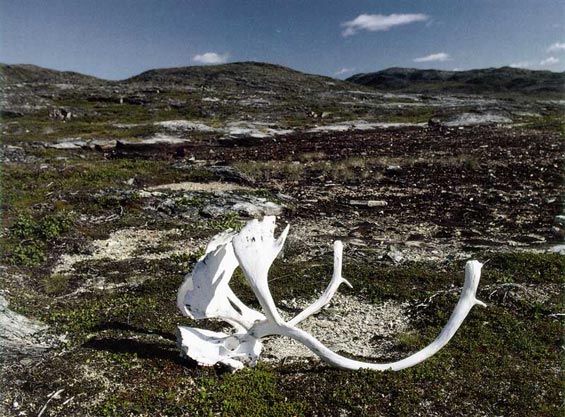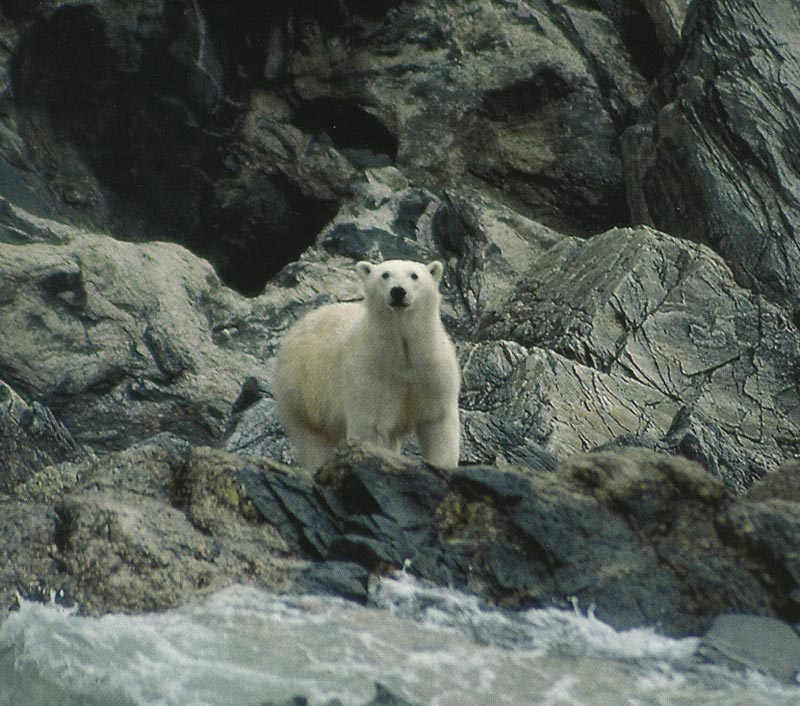What Animals Live in Newfoundland and Labrador
Newfoundland and Labrador Biosphere
The biosphere, all of life on earth, tin can be subdivided into distinct geographical regions called biomes. A biome is a region with a singled-out climate and characteristic plants and animals. Newfoundland and Labrador is really office of two different biomes - tundra and taiga.
The Tundra
The tundra is a sub-arctic zone characterized by long, cold winters and brusk, warm summers. Atmospheric precipitation is low and in the grade of rain and snow. It is sometimes referred to equally a cold desert. The soil a meter down is permanently frozen and is called permafrost . Since h2o cannot easily drain through the soil because of this underlying permafrost, water tends to collect in shallow pools. The landscape, devoid of erect trees and alpine shrubs, is dominated by depression shrubs, mosses, lichens and small flowering herbaceous plants. The characteristic animals of the tundra biome include arid basis caribou, musk ox, chill wolf, arctic fox, arctic hare, emmings, and a variety of voles. The polar bear is the dominant carnivore. Many birds migrate to this area in bound to lay their eggs and rear their young before flying south to warmer areas for the winter.

Tundra Biome of the Littoral Barrens, Northern Labrador
The antlers lying on the ground signal the presence of caribou and other wildlife in this region.
Reproduced past permission of Brian C. Bursey. From Brian C. Bursey, Exploring Labrador (St. John'south, NL: Harry Cuff Publications, ©1991) 87.
The Taiga
The taiga mostly lies to the south of the tundra and is typified by very depression winter temperatures, a longer growing season than the tundra, and more precipitation in the form of rain and snow. The soils are generally acidic and lack in important nutrients such equally nitrogen and phosphorus. This biome is dominated past coniferous trees, especially balsam fir and black bandbox, with white birch, trembling aspen and mount ash being the commonest deciduous trees. The characteristic animals of this biome include moose (the biome is sometimes called the spruce-moose biome), blackness bear, Canada lynx, ruby-red flim-flam, pine marten, short-tailed weasel, and mink. Beaver, muskrat, and river otter abound in the numerous rivers, lakes and ponds. There are too big expanses of wetlands, especially bogs and fens in this biome.
Labrador
Northern Labrador is a typical part of the tundra. Southern Labrador is an example of the taiga. The island of Newfoundland is not typical of either as information technology does not possess many of the animals and plants institute in other areas of North America. This is due to the glaciers which covered the island during the last water ice age until about 10,000 years ago. Since the island emerged from the water ice age basically devoid of found and fauna life it had to be recolonized from the side by side mainland. The predominantly westerly winds blew lichen and moss spores onto the island, and perhaps fifty-fifty lite seeds. But not all plants fabricated the journey and so the island has fewer plants than adjacent mainland areas. Flight insects and birds came across, every bit could swimming animals (beaver, muskrat, otter) and some other animals crossed the sea ice that forms between the island and the mainland during winter. Merely freshwater fish capable of surviving in seawater managed to swim to the isle. No hibernating animals crossed (i.e. chipmunks, frogs etc.) The native mammals are few in number; while Labrador has some 42 native mammals, the island of Newfoundland is abode to only 14. In that location are no raccoons, skunks or porcupines on the isle. Yet, although snakes are non native to the island, since at least 2009 according to a CBC news written report, they take been found breeding in western Newfoundland.
The Island of Newfoundland
The island has a very high proportion of alien herbaceous plants and insects. This is due to the long history of European settlement; human being migrations are accompanied by floral and faunal migrations, either accidentally (in animate being feed) or intentionally (as garden plants). Moose, snowshoe hare, crimson squirrel, striped chipmunk, and masked shrew, amidst others, have been introduced to the island through specific wildlife mandates.
The Declension
The marine waters around the province are considered to be boreal or sub-Chill in nature. During winter sea ice forms along the coast of Labrador and along the west and north eastward coasts of the isle of Newfoundland. Summer surface water temperatures rarely exceed 16 degrees Celsius.

Polar Carry
Although mutual in the tundra region, polar bears are often seen in locations further due south. This by and large occurs in the leap as sea ice forth the Labrador coast breaks upwards and is carried southward by the ocean'due south currents.
Reproduced by permission of Brian C. Bursey. From Brian C. Bursey, Newfoundland and Labrador Souvenir Book (Canada: Friesen Printers, ©1997) 48.
Much of the coastline is rocky, providing attachment for a wide variety of institute and fauna life. The dominant plants of the shoreline are the big brown seaweeds (especially the bladder, forked and knotted wracks, and winged and saccharide kelps), although there are as well a number of ruddy and green seaweeds present. Common animals of the seashore region include barnacles, tortoiseshell limpet, periwinkles, blue mussel, sea anemones, body of water slugs, body of water urchins, sea stars, and stone crabs. The deeper offshore waters are habitation to a diverseness of fish (cod, sculpins, cunners etc.), and marine mammals (dolphins, porpoises, and whales). A number of seals are ordinarily found around the coasts with harp and hood seals giving birth to their young on ice floes during the spring.
What Animals Live in Newfoundland and Labrador
Source: https://www.heritage.nf.ca/articles/environment/newfoundland-labrador-biosphere.php


It was as if you had transported me to my own comfortable living room.
ReplyDeletehttps://crackguru.net/activepresenter-pro-edition-crack/